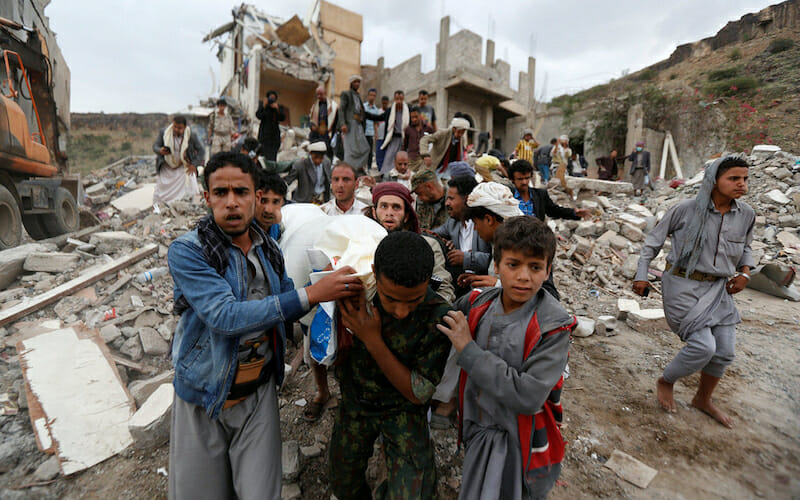
Only the United States can Save the Yemeni People
The United States must lead the world in supporting the Yemeni people. At a time of mass atrocities in Syria and state-directed genocide in Myanmar, Yemen has climbed the ranks of catastrophe to become host to the world’s worst humanitarian crisis. The U.S. has demonstrated a strong capacity to address the emergency through negotiations with Saudi Arabia, the nation leading a military coalition to quash a rebellion by Houthi armed forces. The U.S. should continue with its diplomatic initiative to restore greater access to the country for aid agencies.
There are multiple compounding dimensions to the current emergency and humanitarian actors are best-suited to address the plight of the Yemeni people. However, the United States can do its part by improving their access to Yemen by land, air, and sea. It is times like these when the United States must utilize the strong diplomatic presence it maintains in the Middle East.
Yemen is host to a complex crisis. As the poorest nation in the region, fighting between the Saudi-led coalition and Houthi rebels has exacerbated preexisting conditions of poverty and underdevelopment. Coalition air strikes have both taken civilian lives and destroyed some of the country’s most vital infrastructure. More than 50% of the Yemeni population lacks access to clean drinking water, a driving force behind the cholera epidemic that reached record-breaking levels in October 2017. Despite cholera’s relatively simple cure, the afflicted often do not have anywhere to turn for help, as over half of Yemen’s health facilities are either closed or only partially-functioning. These dire circumstances have combined to make life extremely difficult for the Yemeni people.
However, the international community can effectively address Yemen’s plight. The crisis has escalated through four distinct but mutually-reinforcing manifestations: violence, hunger, thirst, and disease. There have been over five thousand direct casualties of the ongoing conflict. In addition, the war has also sent millions of Yemeni civilians fleeing in every direction, forcing them to resettle far away from their homes. More than 11% of Yemen’s population has been displaced over the last three years. Often ending up in unfamiliar territory, these men, women, and children must compete with local populations and with each other for scarce resources.
The result is that everyone is worse off, with food and water shortages fueling increased rates of malnutrition and disease. The humanitarian community can help to dissuade further displacement and orchestrate a strategic relocation of Yemeni civilians away from high conflict zones. Aid agencies are also well-equipped to provide food and medical support through in-kind donations of food packages and medicine, as well as through the importation of doctors and other medical practitioners.
Humanitarian support is currently limited by the Saudi government’s blockade. First implemented in March 2015 as a measure to stop weapons from reaching rebel fighters, the blockade was tightened in November 2017 following a Houthi attack on Saudi soil. The flow of humanitarian assistance into Yemen has slowed to a trickle as a result, pushing the country to the “brink of a catastrophic famine,” according to the U.N. Security Council. Malnutrition, unsanitary conditions, and broken infrastructure have compounded to perpetuate a recent diphtheria outbreak, which more than doubled from 471 cases to nearly 1,300 cases from January to March of this year.
The United States has played a pivotal role in easing the Saudi government’s blockade. The U.S. has capitalized on its healthy diplomatic relations with Saudi Arabia to negotiate a temporary opening of Hodeida, Yemen’s largest port. Lifesaving supplies can now begin to reach the Yemeni people.
The UN World Food Programme has successfully imported much-needed food packages since the port’s reopening in December 2017. It has also allowed the World Health Organization (WHO) to distribute diphtheria vaccinations within the capital city of Sana’a to curtail the spread of the disease. However, there are still large portions of the population that WHO cannot reach without the establishment of additional entrepots. Furthermore, Hodeida as Yemen’s sole access point leaves essential food and medical supplies highly-exposed to theft and destruction, as proven last month when a port warehouse caught fire.
The United States must continue to restore greater and more-regular access to Yemen for aid agencies. The momentary relaxation of import restrictions in Hodeida could reach a spontaneous end at any time. Thus, the U.S. must act to ensure current in-flows of food, medicine, and relief workers are not just maintained, but bolstered and diversified.
As a next step, the United States should make the Saudi government aware of the potential fallout if it does not relax its tight grip. Internal support for the Houthi rebellion will likely increase as Yemeni civilians become more desperate. It is in the Saudi government’s best interest to allow the international community to expand humanitarian assistance within the country. Hodeida is in western Yemen and the port’s re-opening has primarily helped populations within that same region. The U.S. should now turn its attention to the southwestern corner of the country, where a large portion of Yemen’s internally-displaced has settled. The southwestern governorate of Taizz alone hosts 15% of this population, all of whom could benefit from a more-localized influx of aid and humanitarian support.
If the U.S. wishes to maintain its strong diplomatic presence in the Middle East, it must act when conditions in the region are most dire. The way forward is clear. The time for action is now. The United States must take a leading role in assisting the Yemeni people.
